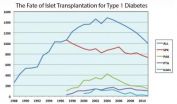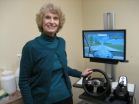(Press-News.org) Organ-transplant recipients often reject donated organs, but a new, two-pronged strategy developed by UC San Francisco researchers to specifically weaken immune responses that target transplanted tissue has shown promise in controlled experiments on mice.
The hope is that using this novel treatment strategy at the time of transplantation surgery could spare patients from lifelong immunosuppressive treatments and their side effects. The approach might also be used to treat autoimmune diseases such as type 1 diabetes, the researchers said. The study is published and commented upon in a recent issue of American Journal of Transplantation.
The study was conducted in mouse studies of islet-cell transplantation -- a procedure used to restore insulin secretion and control over glucose levels in the blood in patients with life-threatening diabetes. The treatment allowed more than 70 percent of mice to accept transplants without requiring any long-term treatment with immunosuppressive drugs.
The approach, led by Diabetes Center member Qizhi Tang, PhD, involved using cells from donors to activate immune cells called donor-reactive effector T cells. The researchers then gave the mice a drug called cyclophosphamide, known to specifically kill activated cells.
Up to 80 percent of the donor-reactive effector T cells, which play a major role in transplant rejection, were eliminated by this treatment. However, that procedure alone did not prolong survival of transplanted tissue.
That required a second step: Some of the mice also received cell therapy — an expanded population of cells called TREGs that quell immune activity. Seventy percent to 80 percent of these mice accepted the transplants, without requiring any long-term immunosuppressive drugs.
Significantly, when the cell therapy was used only in those cells that specifically target donor tissue, only one-fifth as many cells were needed to prevent transplant rejection, the UCSF researchers found. The bigger bang per cell may bode well for clinical protocols, Tang suggested.
An inkling that such a two-pronged approach might work in humans came from the unanticipated outcome of an islet-transplantation clinical trial at UCSF Medical Center, in which a new drug regimen killed effector T cells, allowing another type of immune cell, the TREGs, to quiet the rejection response. One patient in that study now has functioning islets and has been free from immunosuppressive therapy for more than one year.
Controlled clinical trials to evaluate a similar approach for liver and kidney transplantation are in the planning stage, according to Tang, an associate professor of surgery and the head of the Transplantation Research Laboratory at UCSF. "The clinical trial design incorporates what we found in the mouse islet transplant model," she said.
Depleting T Effector Cells, Boosting TREG Cells
Both immune-cell populations that Tang and colleagues manipulated in the mouse studies are T cells, a branch of the immune system's armed forces.
Production of effector T cells normally is ramped up in response to foreign invaders such as infectious disease microbes. However, their numbers also increase to battle foreign, transplanted cells, and they are abnormally activated in autoimmune diseases such as type 1 diabetes, in which effector T cells attack insulin-secreting beta cells of the pancreas.
Another type of T cell used in Tang's studies, the regulatory T cell, or TREG, normally helps calm the immune system after microbial foes have been vanquished, and may help prevent excessive collateral damage to tissues that might otherwise result from immune responses.
In recent years, transplant teams have begun testing immunosuppressive drugs near the time of surgery that preferentially knock down T effector cell populations — hoping to lower the chances of transplant rejection — with the expectation that patients would still require some kind of lifelong immunosuppressive therapy.
In the recent human islet transplantation study, UCSF researchers discovered that the Genentech drug Efalizumab not only did an excellent job of suppressing T effector cells, but also dramatically increased TREG populations. This effect ultimately allowed one patient to go off immunosuppressive therapy completely, Tang said, and raised hopes that the two-pronged approach could be developed to prevent transplant rejection.
To boost TREGs, Tang and TREG research pioneer Jeffrey Bluestone, PhD, the A.W. and Mary Margaret Clausen Distinguished Professor of Metabolism and Endocrinology at UCSF, have for years been developing methods to collect TREGs from the body, to then expand their numbers in the lab, and finally to return them to the transplant patient.
A UCSF phase 1 clinical trial to evaluate TREGS for the treatment of type 1 diabetes has recently concluded patient recruitment. The team is actively planning a follow-up phase II trial to begin recruitment early in 2014, Tang said.
Clinical Trials in Organ Transplantation Expected Next Year
In another UCSF study published online in September in American Journal of Transplantation, Tang, Bluestone and colleagues described a way to preferentially grow human TREGs in a clinical laboratory that are specifically targeted to protect donor tissue.
The U.S. Food and Drug Administration has approved the use of the donor-targeted TREGs in liver transplant patients in clinical trials, Tang said.
"We decided to go with liver transplantation first, because the therapy is new, and liver grafts are more resilient," she said. "We are also actively seeking approval for the use of this product in kidney transplant patients. We anticipate that these trials will start later this year."
INFORMATION:
Co-authors of Tang's latest American Journal of Transplantation study include postdoctoral fellow Karim Lee, PhD, and research specialist Vinh Nguyen; Kyung-Mi Lee, an immunologist at Korea University, Seoul, and Sang-Mo Kang, MD, a transplant surgeon and an immunologist at UCSF.
The most recent study was funded by a donation from the Joyce and Fred Nicholas Family, the Korea Foundation for International Cooperation of Science and Technology (KICOS), and by the National Institutes of Health.
UCSF is a leading university dedicated to promoting health worldwide through advanced biomedical research, graduate-level education in the life sciences and health professions, and excellence in patient care. It includes top-ranked graduate schools of dentistry, medicine, nursing and pharmacy, a graduate division with nationally renowned programs in basic biomedical, translational and population sciences, as well as a preeminent biomedical research enterprise and two top-ranked hospitals, UCSF Medical Center and UCSF Benioff Children's Hospital.
New organ transplant strategy aims to better prevent rejection
UCSF approach might end lifelong drug treatment
2014-03-11
ELSE PRESS RELEASES FROM THIS DATE:
Bending the light with a tiny chip
2014-03-11
Imagine that you are in a meeting with coworkers or at a gathering of friends. You pull out your cell phone to show a presentation or a video on YouTube. But you don't use the tiny screen; your phone projects a bright, clear image onto a wall or a big screen. Such a technology may be on its way, thanks to a new light-bending silicon chip developed by researchers at Caltech.
The chip was developed by Ali Hajimiri, Thomas G. Myers Professor of Electrical Engineering, and researchers in his laboratory. The results were presented at the Optical Fiber Communication (OFC) conference ...
Detecting, testing, treating rare diseases: Technology delivers new era of personalization
2014-03-11
LOS ANGELES (March 10, 2014) – A team of researchers from the National Institutes of Health, Emory University and Cedars-Sinai – specialists in identifying and treating very rare diseases – used three innovative tools to detect a previously unknown gene mutation, test potential therapies in the lab, and initiate personalized drug treatment for a boy with a lifelong history of uncontrollable seizures that caused significant impact on his cognitive and social development.
"This personalized medical approach exemplifies the power of current research tools and shows the immense ...
Study using driving simulator determines when it's safe to drive after hip replacement
2014-03-11
After hip replacement surgery, many patients are anxious to resume driving, and a new study challenges the conventional wisdom that patients should wait six weeks before getting back behind the wheel. Dr. Geoffrey Westrich, director of research, Adult Reconstruction and Joint Replacement at Hospital for Special Surgery in New York City, found that patients in the study were able to return to driving four weeks after total hip replacement.
The study, titled, "A Novel Assessment of Driving Reaction Time Following THR Using a New Fully Interactive Driving Simulator," will ...
New MRI can 'see through' metal screws to follow patients after hip fracture surgery
2014-03-11
People who sustain the most common type of hip fracture, known as a femoral neck fracture, are at increased risk of complications. A special type of MRI developed at Hospital for Special Surgery in collaboration with GE Healthcare can show a detailed image following fracture repair, without the distortion caused by metal surgical screws that are problematic in standard MRIs.
Each year, more than 340,000 people suffer a broken hip in the United States. The femoral neck, the area just below the ball of the hip's ball-and-socket joint, is the most common site of fracture, ...
Study: Women report more pain than men after knee replacement surgery
2014-03-11
Middle-aged women with rheumatoid arthritis or arthritis resulting from an injury are among the patients most likely to experience serious pain following a knee replacement, researchers from Hospital for Special Surgery (HSS) in New York have found.
One of the biggest concerns patients have is the amount of pain they will have after knee replacement surgery. Although it is a very successful operation overall to relieve arthritis pain and restore function, persistent postoperative pain can be a problem for some patients. Researchers at HSS set out to determine which groups ...
Personality may be key risk factor in preventive health care
2014-03-11
WASHINGTON – When it comes to helping young adults avoid serious health problems later in life, assessing their personalities during routine medical exams could prove as useful as recording their family medical histories and smoking habits, according to new research published by the American Psychological Association.
"Health care reform provides a great opportunity for preventive care, with physicians seeing more young adults who may not previously have had insurance," said lead author Salomon Israel, PhD, of Duke University and Duke University Medical Center. "Our research ...
UGA researchers identify decision-making center of brain
2014-03-11
Athens, Ga. – Although choosing to do something because the perceived benefit outweighs the financial cost is something people do daily, little is known about what happens in the brain when a person makes these kinds of decisions. Studying how these cost-benefit decisions are made when choosing to consume alcohol, University of Georgia associate professor of psychology James MacKillop identified distinct profiles of brain activity that are present when making these decisions.
"We were interested in understanding how the brain makes decisions about drinking alcohol. Particularly, ...
A new cell type is implicated in epilepsy caused by traumatic brain injury
2014-03-11
BOSTON (March 11, 2014) — Traumatic brain injury is a risk factor for epilepsy, though the relationship is not understood. A new study in mice, published in Cerebral Cortex, identifies increased levels of a specific neurotransmitter as a contributing factor connecting traumatic brain injury (TBI) to post-traumatic epilepsy. The findings suggest that damage to brain cells called interneurons disrupts neurotransmitter levels and plays a role in the development of epilepsy after a traumatic brain injury.
The research team, led by David Cantu and Chris Dulla, studied the ...
Scientists unlock potential heart attack drug without side effects
2014-03-11
Melbourne scientists are a step closer to creating a new drug to stop a heart attack in its tracks and reduce the damage caused, without any side effects.
The Monash University research, published today in the journal, Proceedings of the National Academy of Sciences, USA (PNAS), offers new hope to thousands of people who experience heart attacks and heart failure – one of the major causes of death worldwide.
Professors Arthur Christopoulos and Peter Scammells from the Monash Institute of Pharmaceutical Sciences (MIPS) led a team of scientists combining molecular pharmacology ...
Researchers show that bold baboons learn to solve tasks from other baboons
2014-03-11
Baboons learn from other baboons about new food sources – but only if they are bold or anxious – according to a new study published in the journal PeerJ). The results suggest that personality plays a key role in social learning in animals, something previously ignored in animal cognition studies.
Studying animals at the Zoological Society of London's Institute of Zoology Tsaobis Baboon Project in Namibia, the researchers examined how personality influenced whether baboons solved foraging tasks and whether they then demonstrated to others how to solve the tasks. They found ...
LAST 30 PRESS RELEASES:
Drone sampling of whale breath reveals first evidence of potentially deadly virus in Arctic
Roman soldiers defending Hadrian’s Wall infected by parasites, study finds
Pinochet’s prisoners were tormented with music but still found solace in it, a new book reveals
Fertility remains high in rural Tanzania despite access to family planning
AI-assisted device can improve autism care access
Kinetic careers
Uncovering how parasitic plants avoid attacking themselves to improve crop resistance
Nanoparticle vaccine strategy could protect against Ebola and other deadly filoviruses
Study finds brain care score can predict risk of stroke across racial groups
Key lung immune cells can intensify allergic reactions
Do hormones explain why women experience more gut pain?
New materials conduct ions in solids as easily as in liquids
Breakthrough of the Year: Renewable energy begins to eclipse fossil fuel-based sources
LLM use is reshaping scientific enterprise by increasing output, reducing quality and more
Introducing LightGen, a chip for ultra-fast, ultra-efficient generative AI
Astronomers see fireworks from violent collisions around nearby star
ACC/AHA issue new guideline on managing congenital heart disease in adults
Cosmic crash caught on camera
Is talented youth nurtured the wrong way? New study shows: top performers develop differently than assumed
Ants: An untapped resource in the development of antibiotics?
Archaeologists use AI to create prehistoric video game
Mitochondria migrate toward the cell membrane in response to high glucose levels
Tiny viral switch offers hope against drug-resistant bacteria
Most parents aware of early peanut introduction guidelines, but confused about details
HPV vaccine can protect against severe lesions of the vulva and vagina
Virtual care provision and emergency department use among children and youth
Quadrivalent HPV vaccine and high-grade vulvovaginal lesions
Insights into dry eyes gained from stem cell-derived tear glands
Researchers identify 166 human pluripotent stem cell lines available for use in clinical applications
Europa Clipper instrument uniquely observed interstellar comet 3I/ATLAS
[Press-News.org] New organ transplant strategy aims to better prevent rejectionUCSF approach might end lifelong drug treatment


